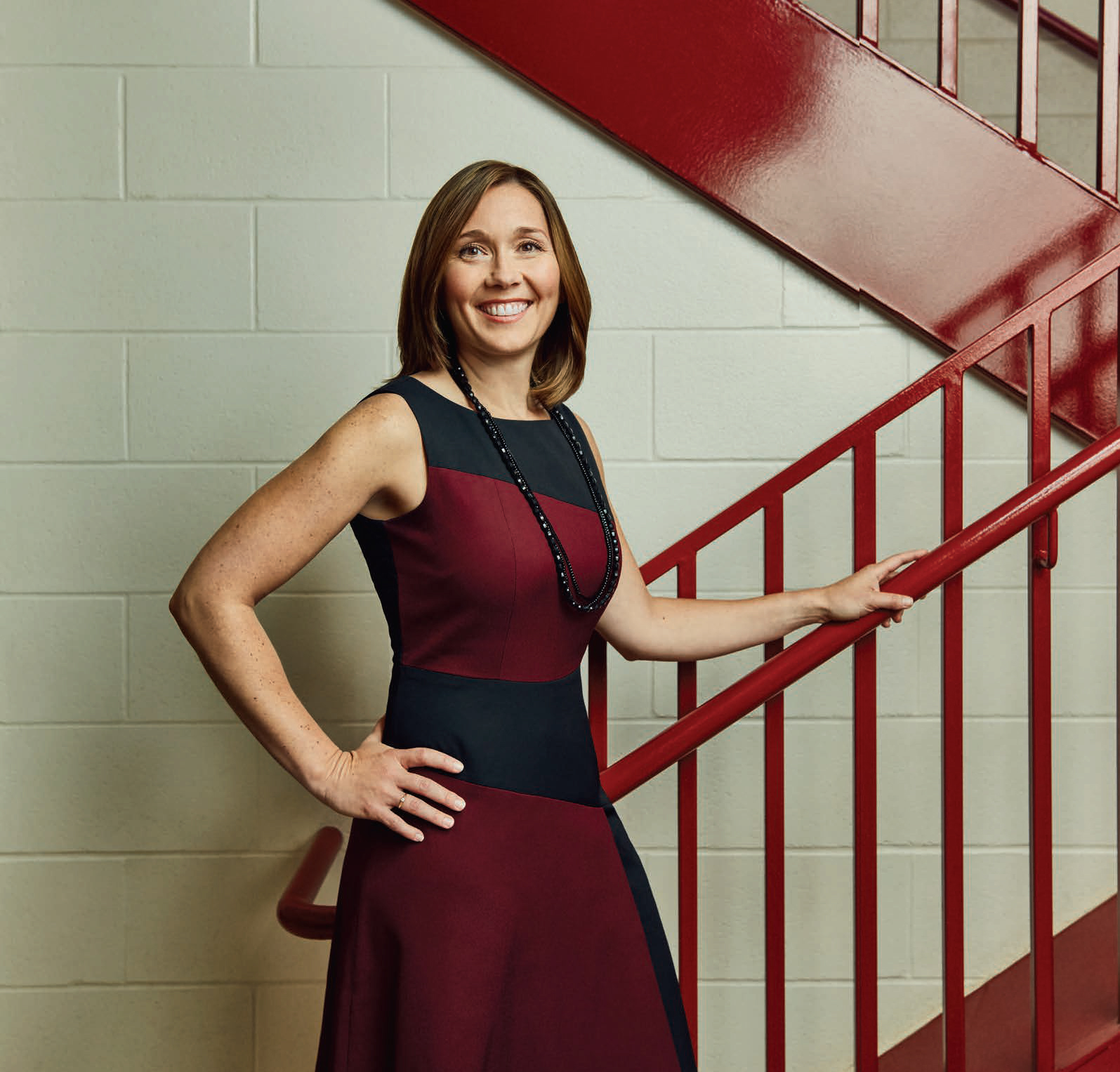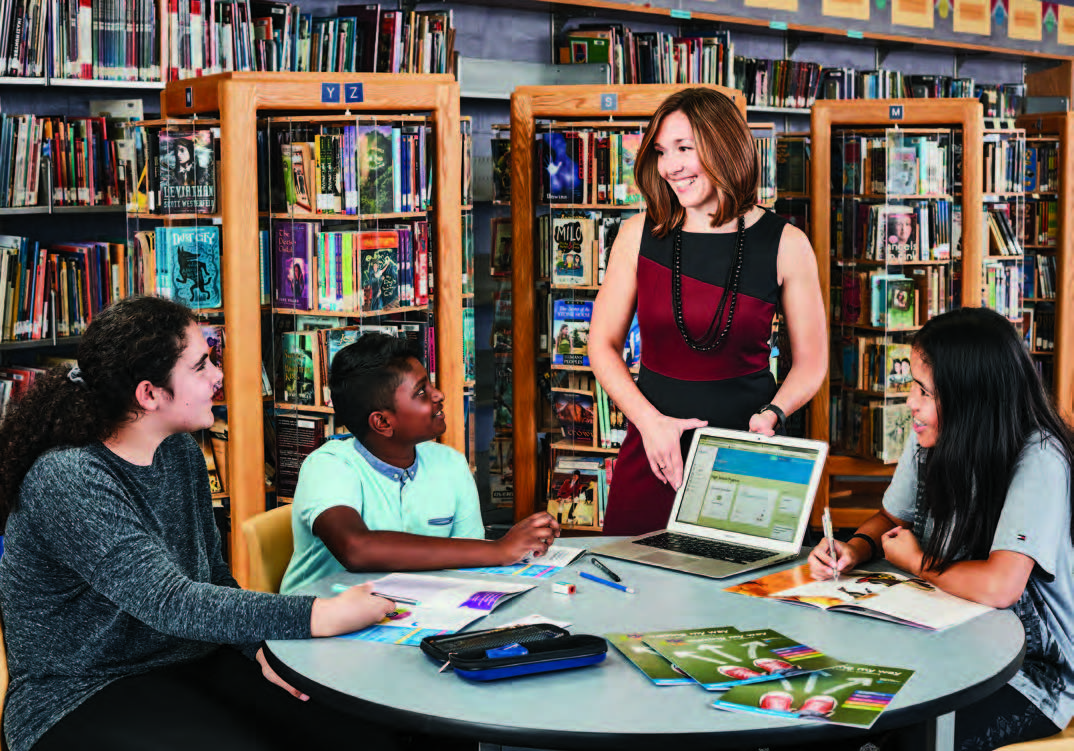Share this page

Amanda Carrol, OCT, ensures teachers and students are equipped to navigate the challenges and changes they face throughout their time at school.
By Jessica Leeder
Photos: Markian Lozowchuk
To view our Great Teaching video archive, visit oct-oeeo.ca/GTvideos
Getting our youth to think critically about their career path is no easy task, but Amanda Carrol, OCT, has found a way to captivate students as young as sixth graders and jump-start their thoughts about jobs.
It goes like this: Carrol, an elementary teacher and guidance counsellor, assembles a class full of students into one corner. With Grade 6s, 7s or 8s clustered around her, she divides the room into four quadrants. One, she explains, is for those who are university bound, while another is for those headed into the workplace. A third quadrant is for college-bound students and she reserves the final for those interested in apprenticeships. Carrol instructs the group to stand in the area that best matches how they see their future playing out.
At first, almost everyone rushes to the university corner. Although, you see a few experience a sort of paralysis. “Some are just frozen,” Carrol says, “and they don’t know what to choose.” This is her cue to launch into the talk she set out to deliver, one that the entire room, stumped and now curious, is sure to tune into.
Keen to show middle school students that they have more options than they likely thought possible, Carrol tries to demystify college by explaining what it offers. She also explains what, exactly, an apprenticeship is — the word being one that many have simply never heard. By the time Carrol finishes, the “game” has students buzzing about their future, which, she reminds them, is actually just around the corner.
No one knows this better than Carrol, who supports the elementary guidance counsellors in the Peel District School Board. These individuals ensure that more than 12,000 Grade 8s are prepared when selecting their high school courses. In fact, the resource teacher specializes in equipping students, parents and teachers across the board’s 87 schools for the unique transition teens experience when crossing over to their fast-paced high school years. Her title is instructional resource teacher for Program Pathways/Grade 7–10 Transitions; Carrol is currently serving the first year of her second three-year term in the job, which is based out of the board office in Mississauga, Ont.

Last year, Carrol’s leadership and achievements earned her the Marion Axford Award for Elementary Guidance from the Ontario School Counsellors Association. It’s an honour that the 15-year veteran teacher is still beaming about. “I always tell people my job is the best in the department,” she says. While that may be true for Carrol, it has not always been easy.
When she left her former school to take this position in 2014, the province had just instituted its Creating Pathways to Success policy a year earlier. Among other things, it mandated that all boards have an online system for Grade 7 to 12 students to do career course and pathways planning. MyBlueprint software was already being used to some extent in Peel, but Carrol’s job was to ensure that all counsellors with students moving to Grade 9 were not merely navigating the basics. They needed to leverage the program’s full potential, which included teaching middle schoolers how to use it. Students could then model an entire high school career’s worth of classes — with an aim to attending university, for example, or scoring an apprenticeship. If they have a particular job in mind, myBlueprint creates a workback plan for attaining it, beginning as early as Grade 8. If they have more than one career path in mind, the software will compare the courses. It is also designed to be inclusive: students, parents and teachers can all take part. The latter, Carrol argues, is critical to student success. “I think it sends a message to the students that parents and teachers are involved in helping you figure out who you are and what you want to be,” says Carrol. “And there’s a lot of different ways you can do that.”
Setting this new order in motion, though, was a mammoth task. But Carrol took it on with gusto. “Unfailingly, she was positive, respectful and happy to help out,” says Adrian Graham, OCT, a former principal who is now Superintendent of Curriculum and Instruction at Peel. “If she couldn’t solve a problem with the person on the phone she’d go over to the school and solve it with them in person. She gave personalized service in a job where there was no expectation that she would ever be able to do that. But that’s the way Amanda works,” he says.
Carrol was driven by her earlier experience as a guidance counsellor in middle school, which can be a complicated and often fragmented role. While the job looks different at every school, it is always a small allocation, with most spending just 20 or 30 per cent of their teaching time in the role. For some teachers, Carrol says, that works out to less than an hour every couple of days. Many have homerooms and teach other subjects. In Peel, Carrol says, the position has seen a lot of turnover. In 2016, nearly half of the region’s 87 elementary counsellors had come into the position in the previous year or two. Carrol’s goal is to lower turnover and create consistency for students by giving counsellors all the backup support she can muster.
“My philosophy is to connect with them [counsellors] and say ‘I’ve been in your shoes. I know what it’s like when you’re trying to meet with a student or parent and the bell rings and you have to go teach math. I know the time crunch you’re in, so tell me what resources you need.’”
"The transition from Grade 8 to 9 is tough; if we’re going to get students over it, we need to make sure they’re engaged."
In addition to making site visits to provide direct help, Carrol offers to connect counsellors with mentors on staff at other schools. She advises them to reach out to community organizations and to establish more than just cursory relationships with the high schools they feed into. The end goal, she says, is to ensure her colleagues are equipped to provide students with the support they need leading up to and during their high school transition.
“We know that the transition from Grade 8 to Grade 9 is tough, and if we are going to get students over it, we need to make sure that they’re engaged,” Carrol says. “I have empathy with those who are a little lost and need a little nurturing.”
This is a quality that inspires others. “Her personality and her drive to achieve is contagious,” says Cheryl Streete, OCT, who is the principal at Bristol Road Middle School. While working under Streete at Glenhaven Senior Public School in Mississauga, Carrol ran a long list of initiatives to support their marginalized students — from setting up mentoring partnerships with adults in the community, to mental health and anti-bullying initiatives. When Carrol left, Streete says, other teachers asked if they could continue her work.
In her new role, Carrol is passionate about building supports for four types of students who face a high risk of stumbling amidst the transition. They are those with attendance issues, mental health concerns, English-language learners and Special Education students. They are all on her radar for custom strategies to improve outcomes. “Those are the four being nurtured or cared for in the elementary setting; there’s potential for losing them in secondary,” she says. To change that, Carrol has worked hard to build processes that will assist her colleagues to better bridge the gap, which includes forging more intimate connections between feeder and high schools.
“In elementary we have the responsibility to prepare them for the environment in secondary. We also have to know that we’re recommending the right program or type of course,” she says. “And we have to give the high school a lot of information, and strategies, to carry over.” Sometimes that’s as simple as ensuring a particular student is registered to take phys-ed in the first semester,” Carrol says, “because that will hook them in.”
Planning for this, Carrol believes, needs to start in Grade 7. A Peel program called the English Language Learner Transition Application Fund (ELLTAF) pairs a handful of English-language learners with high schoolers who take them through a day-in-the-life of Grade 9. They attend classes together, eat in the cafeteria together and ask plenty of questions of their older peers. The goal is to create a less intimidating experience for students who might be put off by the pomp of big orientation days, which often include multiple feeder schools and can have a carnival feel.
At Carrol’s urging, the fund was expanded to include not just Grade 8s but Grade 7s. Her goal is to reinforce students’ sense that there is continuity in their community early on, despite switching schools.
“Whatever roadblocks, hardships or difficulties they’re going to have,” Carrol says, “if they feel they have a community and a place they belong, that is a huge help.”
Working to reinforce this across her board has put Carrol at the top of her game. “We often say in education that it comes down to relationships, and Amanda just innately understands that,” says Graham. “She has a fabulous skill set, a positive attitude and she is always there to help the students.”
The Ontario Certified Teacher featured in this profile has been recognized with a teaching award and exemplifies the high standards of practice to which the College holds the teaching profession.
The transition into high school can be tricky for students. Award-winning Amanda Carrol, OCT, shares five ways guidance counsellors and classroom teachers can help make what is often a tough time for teens a seamlessly smooth experience.
Start Early
Allow families time to process their options by providing parents and students with information about the types of programs and courses they should begin prior to Grade 8.
Involve Parents
Help parents recognize their child’s academic interests, strengths and needs (in and outside of the classroom), so they can have realistic expectations for career options and consider various pathways.
Make Multiple Plans
Encourage students to dream big and look at a variety of post-secondary pathways and occupations that may differ from what their parents chose. When students change their minds (not if!), they’ll be familiar with the process of making decisions, researching options and setting goals.
Work Backwards
Have students begin with an occupation of interest and then research post-secondary programs and related secondary courses, so they understand the connections and stay motivated toward their goal.
Build Resilience
Ensure outgoing elementary students know that secondary school staff are there to help them succeed. Provide them with opportunities to visit their future school and hear from Grade 9s, which will create a sense of belonging. Use discussions about their feelings and concerns as springboards to develop coping strategies. Reassure them that transitions are part of life and growth.